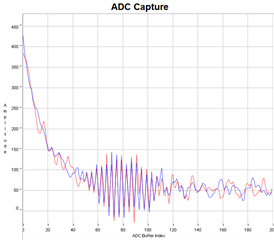Tool/software:
Hi everyone,
I am using the demo code "FR6043_USSSWLib_template_example" for my gas meter setup. In addition I use the Ultrasonic Sensing Design Center to configure my setup properly. When I use both transducers, everything works fine.
To use the Board in pulse echo mode I already tried connecting one transducer to both jumpers. The captured ADC signal was not satisfactory because the transmitted pulse is probably received immediately and superimposed on the reflected signal. The reflected signal needs approximately 110 µs. The ADC capture is shown below. The reflected signal is weak, but a new gas meter setup for pulse echo mode is in development.

I alredy tried different capture sequences when both transducers are connected, but I never received a time of flight of 110 µs. In this context I do not really understand what the capture sequence of CH0_CH1 means. Does it mean, that it excites in CH0 and receives in CH0, then it excites in CH1 and receives in CH0? But according to the schematic of the EVM430-FR6043 the CH1 is not used to excite or receive any transducer signal. Have I misunderstood something here?
So, are there any other possibilities to modify the template to send and receive using only one transducer?
Thank you, Sincerely
Leon


